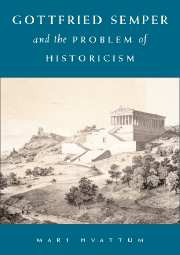Book contents
- Frontmatter
- Contents
- List of Figures
- Prolegomenon
- Introduction – Gottfried Semper: Texts and Interpretations
- PART I TOWARDS A POETICS OF ARCHITECTURE
- 1 The Cult of Origins
- 2 The Doctrine of Imitation
- 3 Semper and the Poetics of Architecture
- PART II PRACTICAL AESTHETICS
- PART III THE APORIAS OF HISTORICISM
- Epilogue
- Notes
- Selected Semper Bibliography
- Bibliography
- Index
2 - The Doctrine of Imitation
from PART I - TOWARDS A POETICS OF ARCHITECTURE
Published online by Cambridge University Press: 06 August 2009
- Frontmatter
- Contents
- List of Figures
- Prolegomenon
- Introduction – Gottfried Semper: Texts and Interpretations
- PART I TOWARDS A POETICS OF ARCHITECTURE
- 1 The Cult of Origins
- 2 The Doctrine of Imitation
- 3 Semper and the Poetics of Architecture
- PART II PRACTICAL AESTHETICS
- PART III THE APORIAS OF HISTORICISM
- Epilogue
- Notes
- Selected Semper Bibliography
- Bibliography
- Index
Summary
“Truth lives on in the midst of deception, and from the copy the original will once again be restored.”
Friedrich SchillerThe cult of origins constituted only the first part of a twofold doctrine central to neoclassical aesthetics. Although the origin theory of Laugier and others identified the source and model for art, it did not address the question of how this model was to be emulated. To do this was the task of the doctrine of imitation. This was a doctrine with ancient precedents, yet one that would, in its enlightenment guise, become a vehicle for a very modern idea of art. Whereas the classical notion of imitation centred around the idea of beauty as mediation of goodness and truth, the enlightenment doctrine of imitation would – paradoxically – approach an ideal of aesthetic autonomy.
Semper never explicitly developed a theory of imitation. On the contrary, he always maintained that architecture, unlike the other arts, was not imitative, and in this lay its virtues: “Architecture has its own store of forms and is not an imitative art like sculpture and painting.” For Semper, the nonimitative arts, under which he grouped architecture, music, and dance, had a privileged position in the aesthetic hierarchy. They were “the highest purely cosmic … arts, whose legislative support no other art can forego.” Semper elaborated this point in one of his most potent statements on architectural imitation:
Tectonics is an art that takes nature as a model – not nature's concrete phenomena but the uniformity and the rules by which she exists and creates…. […]
- Type
- Chapter
- Information
- Gottfried Semper and the Problem of Historicism , pp. 47 - 63Publisher: Cambridge University PressPrint publication year: 2004

